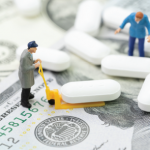Underneath the Hood
GoodRx is essentially the Kayak or the Google Flights of the pharmaceutical world. Flight aggregators work by obtaining real-time information on the cost of specific routes, without requiring the consumer to query each airline individually. GoodRx provides essentially the same service for medications. It partners with pharmacy chains, pharmacy benefit managers and pharmaceutical companies to obtain the real-time cost of any given drug at any of 70,000 pharmacies across the U.S.7
So far, it sounds like I am describing the activities of a charity. Most charities, however, would not command a price of $3 billion on the open market. How does GoodRx generate a profit?
Frankly, I am not entirely sure. The creators of the service, on their website, assure us that when they started, they didn’t even think about how to generate a profit; they were just looking to provide a service. I am sure that is true, just as I am equally sure they eventually realized they could do good and generate a decent profit, simultaneously.
When Mark Zuckerberg was asked by Sen. Orrin Hatch how Facebook could afford to provide services without charging the customer, he famously replied, “Senator, we run ads.”8 The same is also true for GoodRx. In addition to this, just like Facebook and Google and other providers of ostensibly free services, it is undoubtedly squirreling away our data. GoodRx does not require membership, but it is certainly tracking clicks, and as part of the company’s valuation, I am certain that someone thinks those data will have a market value.
Advertising is only part of how it generates a profit. It also functions as a pharmacy benefit administrator. The term you already know is pharmacy benefit manager, which is a company hired by a health plan, employer or government entity to manage a prescription drug program. Functionally, only three pharmacy benefit managers exist—Express Scripts, CVS Health and OptumRx, which together control almost 90% of the market and determine what medications will reach 238 million patients.9
As you know, the pharmacy benefit manager determines which drugs will be part of the health plan’s network, how much the pharmacies will be paid for their services and which drugs will appear on the health plan’s formulary.
Pharmaceutical companies often pay the pharmacy benefit manager to be included on a given formulary. This payment, called a rebate, is why the cost of any given drug to your insurer is likely lower than the list price.10
This leads to the second mechanism for generating profit—the clawback. Because of rebates, the amount the patient pays for a given drug may be more than the absolute cost of the drug. This difference represents additional profit, which is shared between the insurer and the pharmacy benefit manager.11
The difference between the cost of manufacturing a drug and the cost to the consumer can be enormous. For example, an analysis of Medicare data indicates that for each prescription for hydroxychloroquine we write, the manufacturer stands to earn $29.33 in profit. This may not sound like much until you take into account prescription volume. From 2014–18, this markup was worth over $60 million. From Medicare alone. For Plaquenil.12
In the past several years, we have seen the birth of the pharmacy benefit administrator, in which the company retains control of formulary decisions and rebate negotiations. The pharmacy benefit administrator merely processes the paperwork for a fee.13
GoodRx is a pharmacy benefit administrator. As such, it is not beholden to any particular pharmacy benefit manager or pharmaceutical company and can work with all of them, free to direct patients to whichever group seems to be offering the best deal for any given drug. Of course, every time someone uses the GoodRx code to purchase a drug, GoodRx receives a flat fee for taking care of the associated paperwork.



